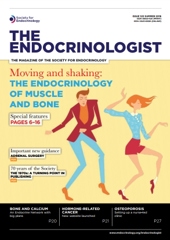The skeleton hanging in the corner of the medical school lecture theatre is an image familiar to us all: an image of medical learning, but also of death. By inference, we see bone as lifeless support, iron girders, for the living soft tissues. However, we are beginning to understand the cellular and molecular functions of bone. It has unique adaptive and regenerative abilities, which allow it to heal and strengthen itself in response to the physiological demands placed upon it. Is musculoskeletal science about to move – away from biomaterials and ‘replace and fix’ – to a biological future of stem cells and chemical manipulation?
A living structure
The functional unit of bone is the osteon. Contained within these linear structures are the mineral and biological matrices required to maintain bone integrity. These units communicate via lacunae to allow a coordinated response to local environmental factors, which influence bony growth. They are separated by boundaries called cement lines (Figure 1). Fractures propagate along cement lines under torsional or bending stress. This structure also gives cortical bone its resistance to deformity when compressed.
Imagine then a structure which is brittle, which fatigues and fractures with repetitive eccentric load, as in the human gait cycle. Are we condemned to a life of repetitive stress fractures? Evidently not, and our saviour in all this is electricity.
Bone generates an electrical field – a piezoelectric charge – when stressed in compression. The piezoelectric charge is not from the mineral content in bone, but arises from the dipole charges in collagen as it undergoes shear stress in response to load. The osteoblasts align along regions of negative charge, along the compressive lines of force (Figure 2). The osteoblasts lay down bone. The opposite is true for areas exposed to tension, or positively charged, where osteoclastic activity is increased. In this way bone adapts structurally to load.
An ageing society
Bone is dynamic and continually remodelling, but we live in an ageing society. In our ageing society, osteoporosis is an epidemic. Bisphosphonates are widely prescribed and highly effective at limiting bone loss in these patients.
Their overall profile is one of bone protection, although there is an up to 47 times higher rate of insufficiency fracture of the femur.1 Radiologically, the bone forms a ‘beak’, which progresses to a radiolucent stress fracture (Figure 3). These fractures are the result of bisphosphonates uncoupling bone turnover and preventing bone remodelling. The term ‘frozen bone’ is often used to describe the local environment of such a fracture, and healing of these fractures is often slowed. Thus, after surgery to stabilise the fracture, the race between fracture healing and implant failure (as all implants will break given time) is tilted towards implant failure. Reversal of this side effect of bisphosphonates remains an unsolved problem.
Stimulation of bone healing
Non-union also occurs in bone with normal turnover. In response to this problem, adjuncts to stimulate bone healing have become a focus of research. Available compounds can be regarded as osteoinductive or osteoconductive.
The conductive substances are scaffolds which rely on local biology to populate the structures with cells. Examples include bioglass, corals, bone pastes and bone allografts. All of these substances are replaced over time by creeping substitution of bone into the graft site.
Osteoinductive substances drive the formation of new bone. Bone morphogenic proteins (BMPs) are a group of inductive adjuncts in common use. BMPs occur naturally and are part of the transforming growth factor β family. These factors are secreted by local bone matrix cells and induce cell division, matrix synthesis and tissue differentiation to promote bone formation. The use of BMPs remains in its infancy in routine fracture management but, in the future, as production costs decline and efficacy improves, these substances could drastically reduce fracture healing times and make non-union of high energy injuries a thing of the past.2
Looking to the future
In treating the degenerative skeleton, total hip replacement is extraordinarily effective, and is probably the most successful lifestyle operation ever devised. Nevertheless, the technology surrounding arthroplasty is now mature and unlikely to evolve dramatically in the future.
Have we reached the end of the story? Probably not. There are two likely avenues of progress: first, joint protection and, secondly, regenerative techniques.
Following intra-articular trauma, we know that secondary degeneration is not simply the product of physical damage, but is mediated separately by chemical factors. For example, we know that interleukin 1 (IL-1) levels remain raised in the synovial fluid after injury. Interestingly, IL-1 inhibitors have been used in murine models to prevent the onset of arthritis after trauma.3
This technology translated into the clinical setting could eventually see attempts to minimise post-traumatic degeneration after healing. Corroborative data from human synovial fluid already exist, so the practical application of this technology is not just fantasy.
On the regenerative front, we are already seeing chondrocyte implantation being used to resurface joints, although in the future it may be that we can make use of biological scaffolds, implanted with chondrocytes, to resurface and reconstitute the joint.4
Thus, molecular biology, at both the chemical and cellular levels, is likely to have an increasing role in the future of orthopaedics. Perhaps musculoskeletal biology, rather than bioengineering, of cells, rather than iron girders, is the future of orthopaedic intervention?
James Brousil
Foot and Ankle Fellow, Division of Trauma & Orthopaedic Surgery, School of Clinical Medicine, University of Cambridge
Andrew HN Robinson
Division of Trauma and Orthopaedic Surgery, School of Clinical Medicine, University of Cambridge
REFERENCES
- Schilcher J et al. 2011 New England Journal of Medicine 364 1728–1737.
- Ronga M et al. 2013 Injury 44 Suppl 1 S34–S39.
- Furman BD et al. 2014 Arthritis Research & Therapy 16 R134.
- Harris JD et al. 2010 Journal of Bone & Joint Surgery (American Volume) 92 2220–2233.





